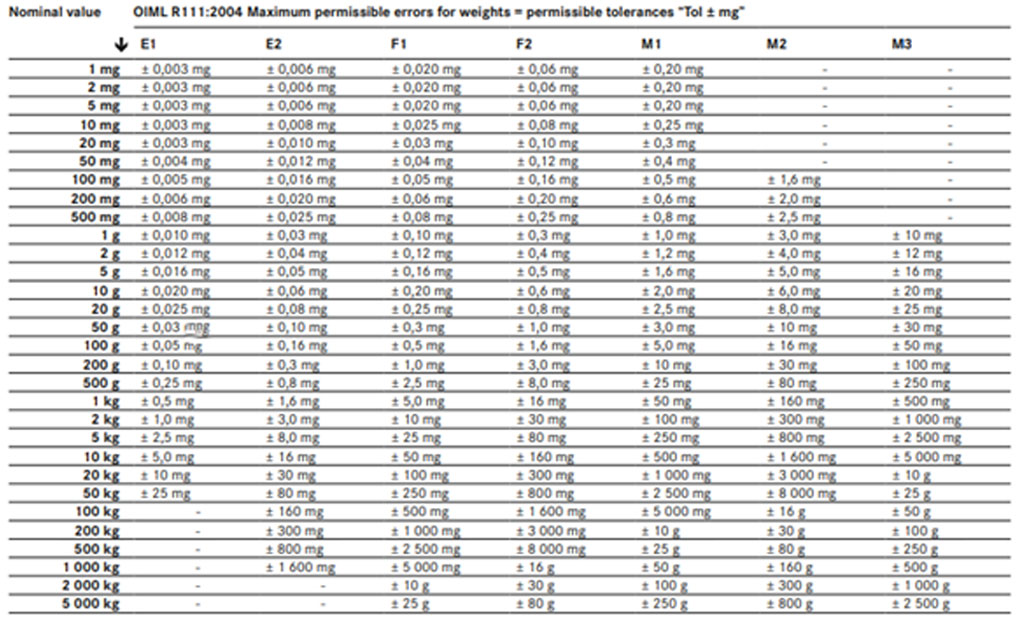We’re here to help
Let us help you
Once you’ve purchased some weighing scales or balances, you’ll still need to regularly test their accuracy and performance. Whether you’re a food manufacturer measuring fresh fruit and veg day-in, day-out, or a packaging specialist using floor scales to weigh bulky items such as crates and large parcels, choosing the correct scales calibration weights for your application is imperative.
But with so many precision weights for calibration to choose from, properly calibrating a scale isn’t as straightforward as it seems. If you’re unsure what calibration weight class is right for your balance or scale, we’ve unpacked this and more to help you achieve accurate weighing results.
A calibrated weight (also known as a test weight) is a precision weight manufactured to very high tolerances and accuracy.
Scales calibration weights are used for applications requiring a precise mass. For applications that require exceptional weighing accuracy such as pharmaceutical products, the weighing equipment will need to be thoroughly tested and calibrated to UKAS standards.
While the weights you require depend on the application you’re using them for, you also need to understand the different weight class systems. There are three main calibration weight classes systems (ASTM, NIST, and OIML), which divides weights into different classes based on the weight tolerance required.
The UK adopts the OIML system, which stands for The International Organisation of Legal Metrology. They are an international standards setting body for legal metrology and set the standards and tolerances for weights, weighing equipment, balances and weighing scales.
Calibrated test weights come in a number of different classes based on their precision, such as M3 (least accurate), M2, M1, F2, F1, E2, E1, and E0* (highest accuracy). In the UK, the Trading Standards Departments of Councils also issue stamped weights that are used when selling products to the public by weight.
Below is a summary of some of the different OIML class weights and their role in ensuring your scales and balances meet precision level requirements.
M3 Class Test Weights – M3 calibration weights are ideal for applications where accuracy requirements are minimal, such as verifying warehouse scales, pallet truck scales, etc.
M2 Class Test Weights – Used in applications such as food processing and general trade where moderate precision is needed.
M1 Class Test Weights – M1 calibration weights are used for routine calibration of general laboratory and industrial scales, including crane scales and platform scales. They are a cost-effective choice when consistency accuracy is essential, but high precision is not required.
F2 Class Test Weights – As well as serving as reference standards for calibrating lower-class weights (M class and below), F2 calibration weights are used for standard tolerance precision balances and scales where medium-precision measurements are needed.
F1 Class Test Weights – Offering mid-range accuracy, F1 weights are widely used in calibration laboratories and manufacturing facilities for calibrating high-quality precision scales.
E2 Class Test Weights – E2 calibration weights have extremely tight tolerances and used in environments like pharmaceutical industries and research laboratories where minimal measurement deviation is critical.
E1 Class Test Weights – E1 weights offers the highest level of accuracy and precision of all the OIML calibration weight classes. However, the tolerances are too tight and are not used generally used for calibration of balances etc. Effectively they would require re-calibration after every use to ensure they have not drifted.
*E0 weights would only be used as a master calibration standard held by a calibration laboratory for the calibration of other weights. Generally a class greater than the ones being calibrated are used, so E0 calibrates E1, E1 calibrates E2, etc.
 Reference table showing the maximum permissible errors (tolerances) for various weights according to the OIML R111:2004 standard.
Reference table showing the maximum permissible errors (tolerances) for various weights according to the OIML R111:2004 standard.
It's imperative you use the correct class of weight to calibrate your balance or weighing Scales, otherwise you will not get accurate results from your weighing scales or balances.
Check out the calibration weight class chart below for the suggested weight class for a particular balance or weighing scale capacity.
| Increment →
Scale Capacity ↓ |
1kg | 100g | 10g | 1g | 100mg | 10mg | 1mg | 0.1mg | 0.01mg |
| Up to 50g | F1 | E2 | E2 | ||||||
| 50 to 100g | F1 | F1 | E2 | E2 | |||||
| 100 to 200g | F1 | F1 | E2 | E2 | |||||
| 200g – 1kg | F2 | E2 | E2 | ||||||
| 1kg – 30kg | M1 | M1 | M1 | F1 | F1 | ||||
| 30kg – 100kg | M1 | M1 | M1 | ||||||
| Over 100kg | M1 | M1 | M1 |
Still unsure about what calibration weight class is right for you? AML are always on hand if you require advice. We also supply a range of calibration weight sets for calibrating scales to OIML tolerances and standards.
Speak to a member of our team on 01522 789375 or email [email protected], and we will be happy to help you on your way to getting precise, accurate results every time you weigh products.
Let us help you